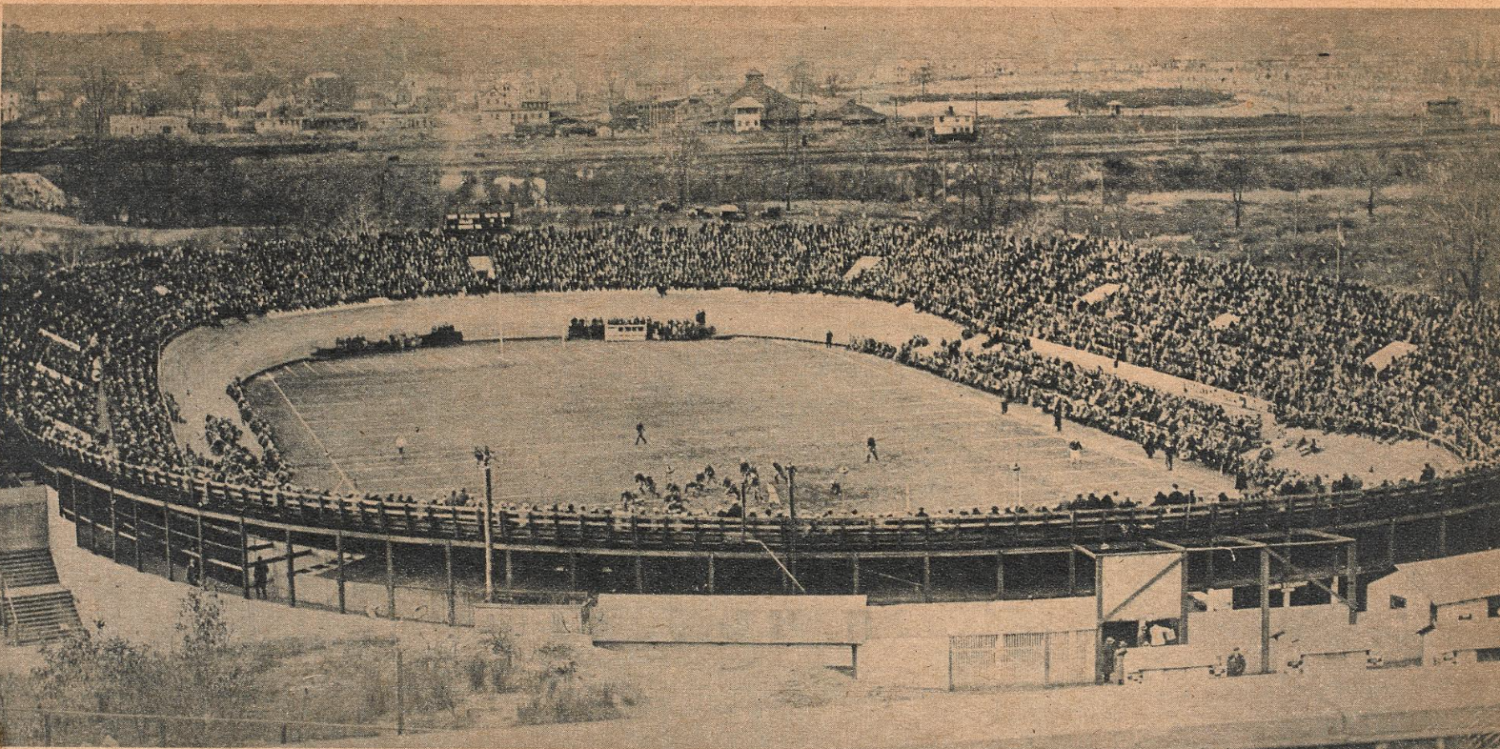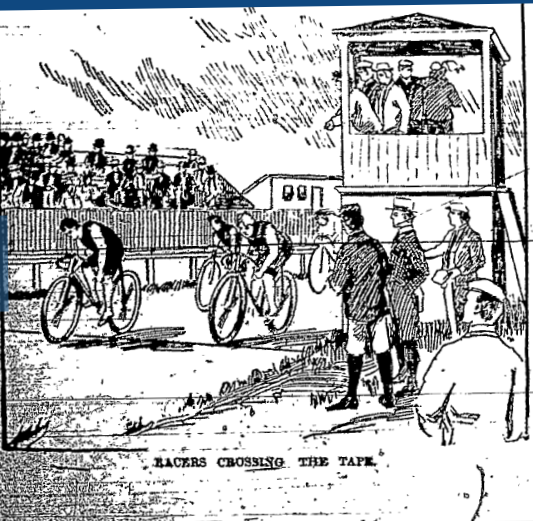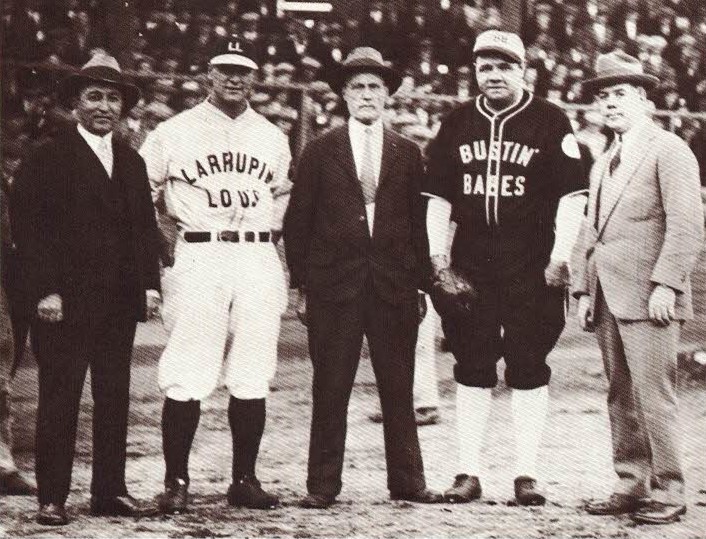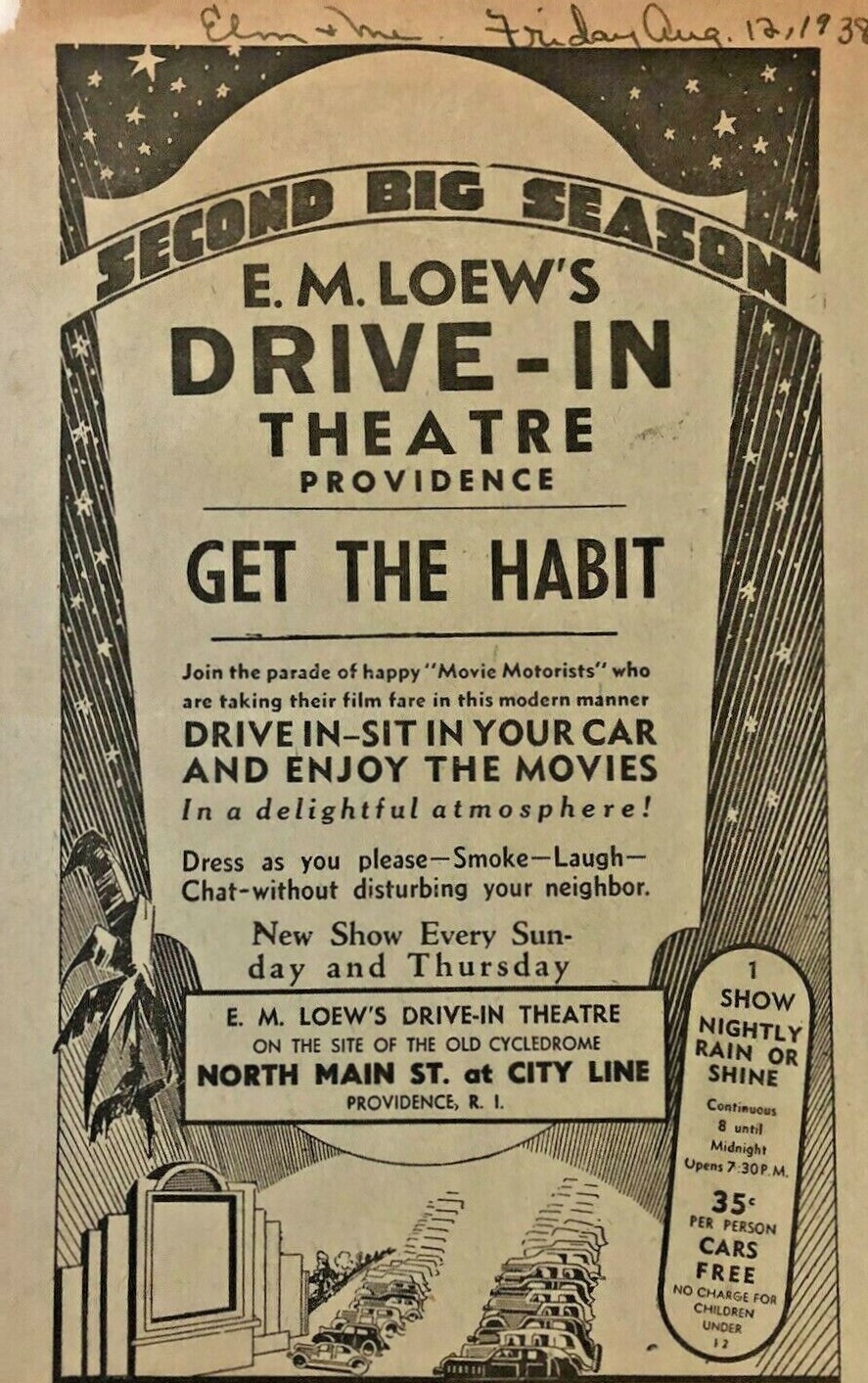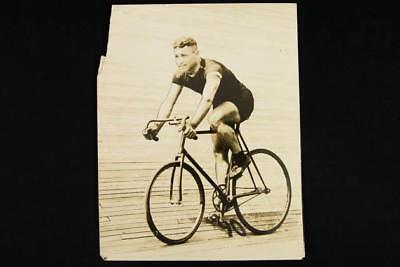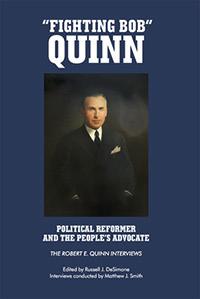Further back than any reader of today can recollect, Providence was once home to one of the nation’s more important sporting venues. Before the Dunk or the Rhode Island Auditorium were built, and even before the appearance of nearby Massachusetts sports centers like the Seekonk Speedway (“Action Track of the East”) and Gillette Stadium in nearby Foxboro, there was the Providence Cycledrome. Located on the Providence-Pawtucket line off North Main Street, it was host to exciting bicycle races, at a time when bicycle racing was a major sport. Bicycle racing helped make famous two Providence Italian-Americans: sports entrepreneur Peter Laudati and professional champion cyclist Vincent Madonna. The Cycledrome was also the home of Providence Steam Rollers, the first New England team to win a National Football League title.
The Cycledrome was not the first cycledrome in Rhode Island, nor was it the first track built exclusively for bike races. There were others that predated it, including one prominent one located in Cranston. (Then called cycledromes in Rhode Island, they are better known today as velodromes.)[1]
Bicycles were a new concept that became a craze during the second half of the 19th century. Despite the rather high cost, many people purchased bicycles and before long the idea of racing bicycles took hold. There were numerous “wheelmen” clubs that help spread the sport of bicycle racing–first for fun and later for money. Soon appeared professional cyclists and specialized venues that would charge admission to watch the races.
The Cycledrome, built in 1925, had bleacher seats that could accommodate 10,000 fans. It was often filled beyond seating capacity when favorite local cyclists were racing or during the Steam Rollers championship football season of 1928. However, it was not the first cycledrome in Rhode Island; nor, for that matter, was it the second.
The Providence Cycledrome was preceded by a few years with another cycledrome, built in Cranston for the Rhode Island Amusement Company. Built on the old Caleb Mann farm at the corner of Reservoir and Park avenues, the Cranston Cycledrome opened in late May 1921. However, it was short-lived, as its last year of operation was 1924.
During its few years of operation, the Cranston Cycledrome hosted a number of exciting racing events planned by its manager Charles Turville. The bicycle season’s opener featured a twenty-five-mile motor-paced race that pitted George Chapman against local favorite Vincent Madonna; Chapman won handily.
In its last year of operation, the Race of Nations, a thirty-mile motor-paced bicycle race, was the featured event of the season with six nations (Australia, Belgium, France, Italy, Sweden and the United States) represented. France’s Gustav Ganay was the winner. Sadly, the Cranston saucer was demolished in the Fall of 1924 after it was sold to the Providence Real Estate Improvement Co. to make room for a new housing development.
Interestingly, even earlier than the Cranston cycledrome was another stadium specifically built for bicycle racing constructed in Providence off Broad Street.[2] Known as the Colosseum, it was built by local theatrical empresario Felix Wendelschaefer, who was also the manager of the Providence Opera House. Built in 1901, the Colosseum’s wooden grandstand was said to accommodate nearly 10,000 spectators. The wooden oval track was built for six laps to the mile. Opening day ceremonies scheduled for Memorial Day 1901 created a frenzy. A crowd of more than 8,000 racing enthusiasts and the simply curious attended. The main attraction was a twenty-five-mile motor-paced race with a $1,000 prize for the winner. It pitted stand-out cyclists Will Stinson against Nat Butler and Bobbie Walthour. Stinson won the purse. In addition to the featured race, other races, with numerous heats in each to determine race finalists, included one-mile novice, five-mile motor-paced amateur, one-mile amateur and one-mile handicap races. Opening day saw two world time records broken for a six-lap track, one for 15 miles and the other for 25 miles. Musical entertainment was provided by the Banda Napoli.
Unfortunately, the Colosseum never turned a profit and as with the bicycle venue twenty-years later in Cranston, it lasted only a few years before it was closed. Despite bicycling races ending in September of 1903, the Colosseum hosted a number of football games by a local football team, appropriately named the Colosseums. By early 1904 the stadium was rumored to be for sale, and soon thereafter, it was demolished to make way for more housing.
Predating the Colosseum were several 19th century parks that featured bicycle racing. Hillgrove Park in Warwick, operated by John Collingwood, was a horse racing venue, but the center of the track’s oval was paved with cement to allow for bicycle races. This park was located near the present day T.F. Green Airport (which was originally named Hillgrove).[3]
Another park was at George Boyden’s Crescent Park in Riverside, East Providence. Crescent Park was one of Rhode Island’s premier amusement centers. This track opened on Memorial Day 1896 and lasted five years. In 1901 the track was taken up and replaced with a baseball diamond. Both parks featured motor-paced bicycle races during the 1890s. A third bicycle park was located at Pawtucket’s Driving Park.
Construction of the open-air Providence Cycledrome was the brainchild of Peter Laudati, a local sprots promoter and real estate developer. Built on the Providence-Pawtucket line off North Main Street, it was readily accessible by streetcar, an important feature as not all sports fans could then afford an automobile. When completed in 1925 the bicycle track was said to be the largest and fastest bicycle track in the United States. The track itself was constructed of wood, with five laps equaling one mile.
The arena was put to good use accommodating some of the best motor-paced bicycle racing in the country that attracted the best cyclists of its day. It also hosted football games, both professional and high school, soccer matches, prize fights, band concerts and other forms of entertainment. To a large degree the success of the events at the Cycledrome was due to the planning of its manager Charles Turville, who came to the Providence venue when the Cranston cycledrome closed.
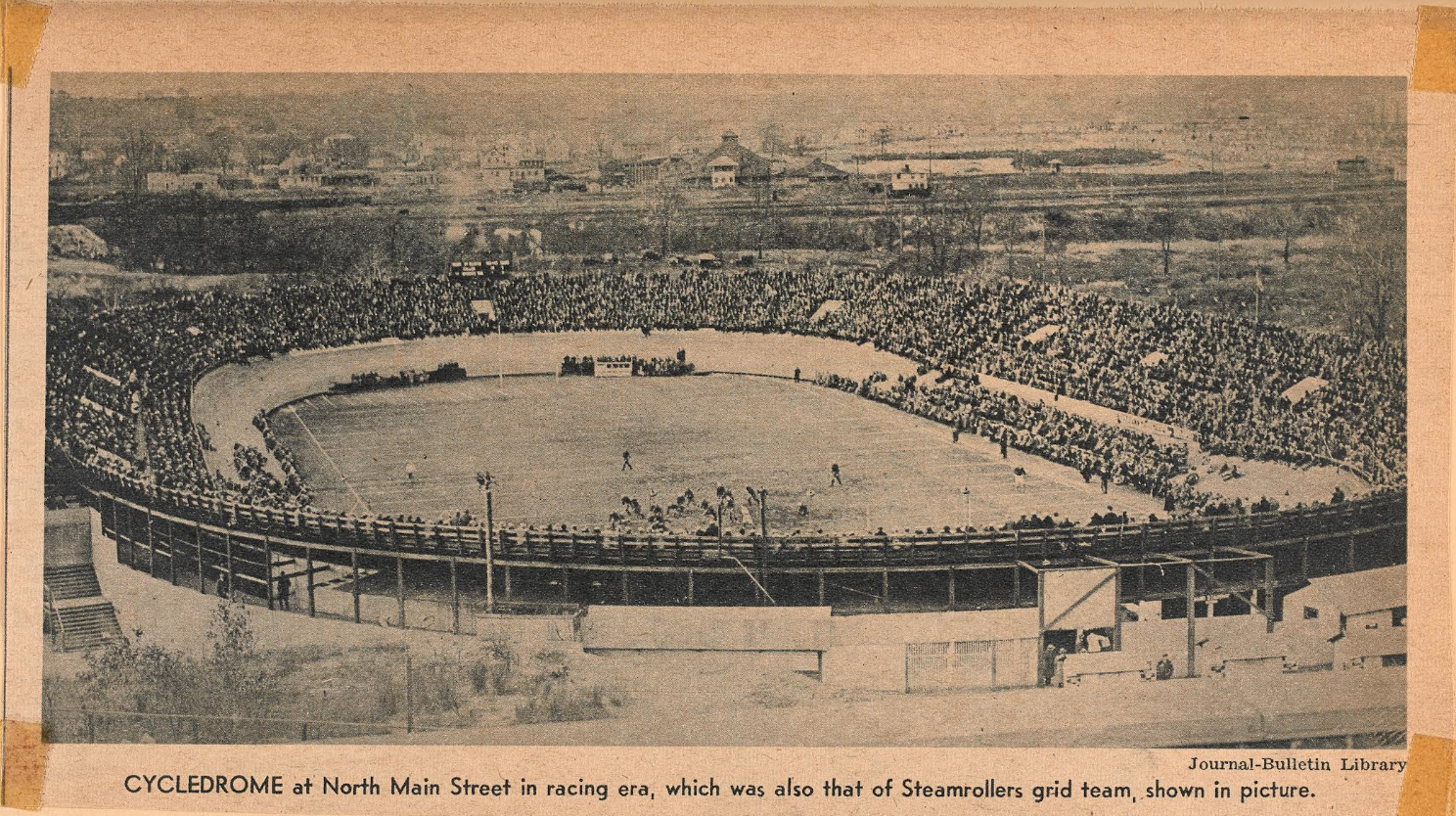
A 1928 arial view of the Providence Cycledrome with a football game in progress. (Providence Public Library).
The sport of high-speed bicycle racing was decidedly dangerous. Accidents with injuries were common. In 1929 the Cycledrome was the site of two racing fatalities occurring just weeks apart.
Twenty-three-year-old Dan Piscione of Thornton, a popular cyclist with the fans, died on August 22, 1929, two days after he was injured while training for the Golden Wheel race scheduled to be held the day he died. Piscione was considered by many to be the heir apparent to the retired Vincent Madonna. Only weeks earlier August Gaethof, a motorcycle pace-maker, was killed when the front tire on the motorcycle his was riding blew during a race.[4] Several cyclists were injured during the accident that killed Gaethof.
The Cycledrome is probably best remembered today as the home stadium of the 1928 National Football League champions, the Providence Steam Rollers (called both in the singular and the plural). The Steam Roller professional football team was formed in 1916 by Charles Coppen and Pearce Johnson, the sports editor and a sportswriter, respectively, at the Providence Journal. The team played initially at Kinsely Park, but in 1925 the team, under the joint ownership of Coppen, Peter Laudati, and James Dooley, moved its games to the Cycledrome, the same year the team joined the National Football League (NFL). The field was inside the steeply banked track, which cut the end zones to just five yards in depth. The team’s most successful year came in 1928 when it won the NFL championship with a record of 8-1-2 under its able player/coach Jimmy Conzelman.
The Steam Rollers would continue to play in the NFL until 1931 when the franchise was suspended at the end of the season. In 1933 the owners turned the franchise back to the NFL.
During its brief tenure in the NFL, it achieved several league “firsts,” both occurring in 1929. The team was the first time an NFL team played a game under the lights when it hosted the Chicago Cardinals; however, this game was played at Laudati’s Kinsley Park and not the Cycledrome. The other “first,” probably never to be matched again, occurred when the team played four league games in six nights. Unfortunately for the home team, despite such extraordinary physical exertions, they resulted in no wins, three losses and a tie.
Peter Laudati was a dominant figure in the history of sports in Rhode Island during the first half of the 20th century. Not only was he the developer and owner of the Cycledrome, he was also involved in numerous other sporting ventures, including baseball, boxing, football, and soccer. Born in 1884 at Sante Croce del Sannio in Italy, he immigrated to the United States with his family when he was twelve years old. As owner of the Peter A. Laudati and Son real estate company, he developed properties in Rhode Island, Massachusetts, and Florida. By the second decade of the 19th century, Laudati was heavily involved as a sports promoter.
Laudati became a part owner of the Providence Steam Rollers professional football team (the other owners were Charles Coppen and James Dooley). In 1924 he developed Kinsley Park in Providence.[5] The park was home for a time not only to the Providence Steam Rollers, but also to the Providence Grays professional baseball team. In addition, it staged boxing events and soccer games. It was at Kinsley Park where the famous 1927 barnstorming baseball game between Babe Ruth’s Bustin’ Babes and Lou Gehrig’s Larrupin’s Lous took place in early October–Gehrig’s team won 13 to 7. For more details about this charming baseball game see Christian McBurney’s account at Small State Big History: Babe Ruth and Lou Gehrig Play an Exhibition Game in Providence, Kids Go Nuts – Online Review of Rhode Island History (smallstatebighistory.com).
As a testimonial to Laudati’s entrepreneurial spirit, after the Cycledrome was finally demolished, the promoter built on its site the E.M. Loew drive-in movie theater. When the drive-in opened in 1937 it was only the third drive-in movie theater in the country. One account in the Providence Journal noted that a building permit was issued to Laudati for the building of a stage for $3,000 and the cost of the total project including grading of land, building ramps and installation of equipment was projected to cost $50,000–a huge sum of money during the Great Depression years.[6]
The Providence Cycledrome was considered the best bicycle stadium in the nation when it opened in 1925. As such it drew the top names in the sport of cycling, but no name was greater than that of Vincent Madonna. Born in 1890 in Aversa, Italy, he came to the United States as a young man in 1909. Madonna had already made a name for himself long before the Providence Cycledrome was built. He started his bicycling career in 1914, winning his very first race and the $50 purse. He won most of the races he entered. After residing in New York City, Madonna made Providence his home for almost two decades.
In a 1980 account published in the Providence Journal, Madonna recounted how when he first turned professional the other racers were organized against him and attempted to slow him down by obstructing his path. Madonna said he felt that he had to prove himself. He peddled as fast as he could, not letting up. When the race was over he learned he had lapped the rest of the field three times over.
Madonna became a fan favorite, cycling often at the Cranston cycledrome to the cheers of “Poosh-a-Madon”. In 1921 he entered his first international competition and won. He would go on to win many races not only at the Cranston and Providence cycledromes, but also at the Velodrome in New York City and another track at Coney Island. One New York newspaper noted, “The Italians howled themselves hoarse and they burned red fire in Mulberry Bend over the wonderful motor-paced riding of their idol, Vincent Madonna.”[7]
In 1922, a race billed as the “battle of the cycling century” was staged at the Cranston cycledrome between Madonna and one of the top European racers, Victor Linhart. The two split the first two races and the third ended in controversy. So they held a fourth heat of five miles, and Madonna won. More than 9,000 fans attended the day’s races.
While cycling in Philadelphia, Madonna set a record-setting pace of 67 miles-per-hour. But he was more than a speed racer; he also entered endurance races. In 1917 the five-foot-two star peddled 900 miles in a 24-hour period. Each of these records was an amazing accomplishment.
Perhaps his greatest achievement occurred in 1926 when he captured the championship at the New York Velodrome and the succeeding day won the “Golden Wheel” title at Providence’s Cycledrome. At one point in his career, he ran a winning streak of fifteen consecutive races.
Madonna was called the “Babe Ruth of cycling” in the 1920s. Warren Walden, the noted Rhode Island sportscaster of the mid-20th century, called Madonna “the greatest of all bike racers” and added that “He held a place in bicycle racing similar to that occupied by Joe DiMaggio in baseball in later years.”[8]
When he raced in Providence, the fans came out. It was best said by Earl Lofquist in his newspaper column Inside-Out: “Madonna, the original ‘poosh em’up,’ was a particularly powerful figure at the gate, partly because he was a home product and Federal Hill’s greatest gift to the sports scene up to that time …. Those who would not pay to see him win were quite willing to see him beaten. Either way, the cash came through the turnstiles.”[9]
While the Providence Cycledrome was said to hold 10,000 patrons, it was often filled to overcapacity due to large numbers of Italian-American immigrants from nearby Federal Hill, Silver Lake, Eagle Park and elsewhere who came to see local Italo cyclists Vincent Madonna, Cranston standout Dan Piscione, and many others including the young Frank Madonna, nephew of Vincent Madonna, who turned professional the same week of Piscione’s tragic death.
The Great Depression crippled professional bicycle racing. By late 1929 Vincent Madonna was living on Long Island starting a new career as a successful pizza restaurateur and seldom appeared in Providence. The withdrawal of Madonna, the death of Piscione in August, and the Great Depression started by the stock market crash in October also meant financial disaster for the Cycledrome. The stadium, in much need of repair, held on with dwindling attendance until 1934, as the Great Depression continued, when it finally closed. The property was put up for auction several times to pay for back taxes, but there were no takers willing to keep the stadium. The stadium was demolished in 1937.
While today the Cycledrome is little remembered, for a decade, from the mid-1920s to the mid-1930s, it had the best seats in the state for Rhode Island sports fans.
Peter Laudati lived a long and active life, passing away in September 1977 one month shy of his 93rd birthday. Vincent Madonna lived to be 95 years old, and when he was well into his 90s in Florida he was still biking 20 to 25 miles each day. He died in 1986.
In recognition of their accomplishments both Laudati and Madonna will be inducted into the Rhode Island Heritage Hall of Fame in February 2023. Each is an honor long overdue.
Notes
[1] The word “cycledrome” was used to describe an arena for bicycle racing in Rhode Island. In most other areas of the country, the word “velodrome” was more commonly used. Velodrome is a recognized word in most dictionaries while cycledrome is not. [2] Located in the Elmwood section of the city and bounded by Broad, Ontario, and Niagara streets and Lexington Avenue. [3] According to Warwick historian Henry A. L. Brown, the park was located near the corner of Post and Airport roads. Brown added that early in the 20th century, the park held auto races. [4] The Pawtucket Times sports editor gave a glowing account of Gaethofs the day following the accident that killed him, calling him the king of American pace-makers. “Ordinarily, it is the bike racer, and not his pace-maker, who is watched in the races. But not so in the case of Gaethofs. He was an attraction in himself.” Standing erect on his motorcycle for an entire race, including the 50-mile races, he was often referred to as “the little iron man.” Pawtucket Times, August 3, 1929. [5] This baseball park was located at the corner of Kinsley and Acorn streets directly opposite the vast Nicolson Fille mill complex in Providence. [6] Providence Sunday Journal, November 8, 1936. [7] The Evening World, September 27, 1922. [8] Cited in Warren Walden’s newspaper column “Carry On,” in the Cranston Mirror, September 22, 1983. [9] Providence Journal, June 23, 1949.
